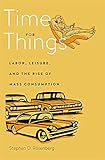Time for Things : Labor, Leisure, and the Rise of Mass Consumption / / Stephen D. Rosenberg.
Material type: TextPublisher: Cambridge, MA : : Harvard University Press, [2021]Copyright date: ©2020Description: 1 online resource (352 p.)Content type:
TextPublisher: Cambridge, MA : : Harvard University Press, [2021]Copyright date: ©2020Description: 1 online resource (352 p.)Content type: - 9780674979512
- 9780674250543
- 330.12/2 23
- HB99
- online - DeGruyter
| Item type | Current library | Call number | URL | Status | Notes | Barcode | |
|---|---|---|---|---|---|---|---|
 eBook
eBook
|
Biblioteca "Angelicum" Pont. Univ. S.Tommaso d'Aquino Nuvola online | online - DeGruyter (Browse shelf(Opens below)) | Online access | Not for loan (Accesso limitato) | Accesso per gli utenti autorizzati / Access for authorized users | (dgr)9780674250543 |
Frontmatter -- Contents -- ONE. Introduction -- TWO. The Puzzle -- THREE. Empirical Pattern in the United States -- FOUR. A Theory of Mass Consumption as Wage-Labor Commensuration -- FIVE. Economic Fairness and the Wage Labor Background -- SIX. Standardization of Consumption, Work, and Wages -- SEVEN. Standardizing Utility: Brands and Commercial and Legal Warranties -- EIGHT. Product Testing and Product Regularization -- NINE. Moral Panic about Utility: Planned Obsolescence -- TEN. Conclusion: Capitalism, Commensuration, and the Normativity of Economic Action -- APPENDIX 1 -- APPENDIX 2 -- Notes -- References -- Acknowledgments -- Index
restricted access online access with authorization star
http://purl.org/coar/access_right/c_16ec
Modern life is full of stuff yet bereft of time. An economic sociologist offers an ingenious explanation for why, over the past seventy-five years, Americans have come to prefer consumption to leisure.Productivity has increased steadily since the mid-twentieth century, yet Americans today work roughly as much as they did then: forty hours per week. We have witnessed, during this same period, relentless growth in consumption. This pattern represents a striking departure from the preceding century, when working hours fell precipitously. It also contradicts standard economic theory, which tells us that increasing consumption yields diminishing marginal utility, and empirical research, which shows that work is a significant source of discontent. So why do we continue to trade our time for more stuff?Time for Things offers a novel explanation for this puzzle. Stephen Rosenberg argues that, during the twentieth century, workers began to construe consumer goods as stores of potential free time to rationalize the exchange of their labor for a wage. For example, when a worker exchanges his labor for an automobile, he acquires a duration of free activity that can be held in reserve, counterbalancing the unfree activity represented by work. This understanding of commodities as repositories of hypothetical utility was made possible, Rosenberg suggests, by the advent of durable consumer goods-cars, washing machines, refrigerators-as well as warranties, brands, chain stores, and product-testing magazines, which assured workers that the goods they purchased would not be subject to rapid obsolescence.This theory clarifies perplexing aspects of behavior under industrial capitalism-the urgency to spend earnings on things, the preference to own rather than rent consumer goods-as well as a variety of historical developments, including the coincident rise of mass consumption and the legitimation of wage labor.
Mode of access: Internet via World Wide Web.
In English.
Description based on online resource; title from PDF title page (publisher's Web site, viewed 18. Sep 2023)


